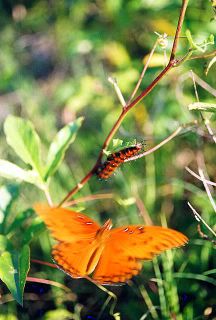
Here's the Gulf Frit. caterpillar defoliating a passion vine. The adult Gulf Frit. flew into the picture as I released the shutter. Sorry the adult is blurry, it was moving too fast for the shutterspeed I was using. What's neat about these insects (besides their great orange color) is the fact that they incorporate toxins from the passion flower vine so that they are poisonous also. That explains the bright color. It's called "Warning Coloration" and it's a reminder to birds that this is not an insect they want to eat.

5 comments:
What a beautiful butterfly! So glad you were able to catch both the caterpillar and the adult in the same shot. That has to be a rarity, especially since you weren't even trying and the butterfly just slipped in. It's amazing how many species of wildlife (i.e. marine life) have some form of inbuilt defense.
I've never had a passion flower, but now you've enticed me. (Wonder if Gulf Frits only live around the gulf.) Is there anything I should know about passion flowers beforehand, such as do the vines have a tendency to choke out other plants?
I truly appreciated your giving us a specific example of "warning coloration" (besides which, I didn't know the term). Although a milkweed plant's leaves are poisonous to most animals, the main diet of Monarch butterflies is milkweed. Monarchs are thus toxic to their predators. No warning coloration involved there, though. Butterfly weed, however, is a member of the milkweed family, and it has bright orange flowers, similar to the color of Monarchs. So there's another example of warning coloration. I have to admit, I didn't tie that together until I read your post!
Hey Darlene,
Always good to hear from you. Like most "rules" in nature, warning coloration isn't always the reason for bright colors, but it is a definite survival adaptation in many animals. Coral snakes use it, yet other venomous snakes like our beautiful diamondbacks stick to cryptic coloration (camouflage). Hand in hand with warning coloration goes "mimicry" where a nonpoisonous animal mimics the color patterns of a poisonous or bad tasting animal.
The monarch butterfly you mentioned has a really bad taste (don't ask me how I know). The almost identical Viceroy butterfly looks like a monarch, but doesn't taste bad. Once a bird eats a monarch it will probably avoid the viceroy. Thus the viceroy benefits from the monarchs bad taste.
Likewise, harmless scarlet king snakes mimic the color pattern of the poisonous coral snake for similar reasons.
It's pretty neat out there...
Oops! I forgot to answer the passionflower question. I don't see it as very invasive. It makes some round fruits that are edible, but kind of taste like styrofoam...(don't ask me how I know what styrofoam tastes like). They sprout along fences and other unmowed areas, but are easily controlled by mowing. As far as the Gulf Frits, I think they are mostly a butterfly of the south.
Wow, thanks, for everything you just wrote. I so appreciate your having put this in perspective for me. It truly is amazing out there. Thanks for the answer on the passion flower, too.
Just wondering, the bright red coloration of the coral snake: Is it just humans who know to back off when they see it? Or animals, too?
Okay, I can possibly understand if you know that Monarchs have a bad taste, but you know I'm wondering, how the heck do you know what styrofoam tastes like?
On the coral snake question, reds and yellows are often, but not always a warning of danger or unpleasantness, so I guess other animals pick up on these tones also.
On the styrofoam...it's a childhood memory of munching a foam cup for a reason that escapes me now. I got a sharper shot of a Gulf Frit yesterday and will get it posted soon.
Post a Comment